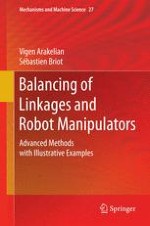2015 | OriginalPaper | Buchkapitel
4. Complete Shaking Force and Shaking Moment Balancing of Linkages
verfasst von : Vigen Arakelian, Sébastien Briot
Erschienen in: Balancing of Linkages and Robot Manipulators
Aktivieren Sie unsere intelligente Suche, um passende Fachinhalte oder Patente zu finden.
Wählen Sie Textabschnitte aus um mit Künstlicher Intelligenz passenden Patente zu finden. powered by
Markieren Sie Textabschnitte, um KI-gestützt weitere passende Inhalte zu finden. powered by
